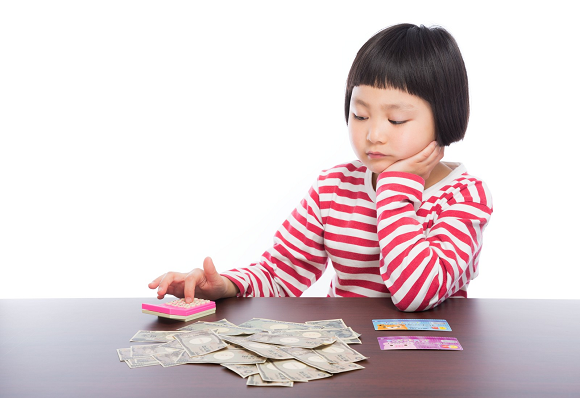
No need to worry about them spending it all in one place when they aren’t going to spend any of it.
Along with visiting shrines and almost killing yourself with mochi rice cakes, otoshidama is part of the New Year’s festivities in Japan. Otoshidama are gifts of cash, placed in colorful envelopes and given to children by older relatives, and are generally the biggest single influx of financial resources most kids will have over the next 12 months.
Toymaker Bandai recently conducted a survey of parents of 900 kids (50 boys and 50 girls from each of the six years of Japanese elementary school and three years of junior high) about their otoshidama haul in 2018. Elementary school-age children received an average of 21,382 yen (US$190), while the middle school kids found themselves 30,507 yen richer in the new year. 91.3 percent said they were given otoshidama from their grandparents, followed by 67.3 percent getting cash gifts from aunts and uncles and 64.4 from parents.
Bandai then asked the survey participants how that otoshidama is going to be used, and the most common response, by far, was “savings,” making up 37.7 percent of the answers. The top ten were:
1. Savings – 37.7 percent
2. Video game hardware/software – 27.7 percent
3. Toys, collectible card games – 21.8 percent
4. Stationery, interior items – 21.1 percent
5. Books (other than manga) – 18.7 percent
6. Candy, juice, soft drinks – 18.6 percent
7. Manga – 16.1 percent
8. Clothing, fashion items – 11.8 percent
9. Playing games at an arcade – 11.2 percent
10. Sporting goods – 6.5 percent
When subdivided by gender, savings slipped to the number-two response for boys, with the top slot going to video games/hardware, at 37.5 percent, just above the 36.2 percent of savings. Girls, meanwhile, kept savings at the top of their list, at 39.4 percent, followed by stationery, books, clothing, and candy.
All those responsible choices, though, may not completely reflect the kids’ true desires, though. While 35.2 percent of the children in the survey are being allowed to use their otoshidama however they want, for 13 percent of them, Mom and Dad are dictating how the funds are to be used, with the remaining 51.8 percent of kids having partial otoshidama freedom. So perhaps when they get older and can truly do whatever they want with their money, they’ll transition from showing fiscal restraint at New Year’s and instead start splurging on Lucky Bag shopping instead.
Source: Bandai via IT Media
Top image: Pakutaso
Follow Casey on Twitter, where it’s already February but he still hasn’t eaten soba in 2018.

 At what age should parents stop giving kids New Year’s otoshidama money? Japanese netizens answer
At what age should parents stop giving kids New Year’s otoshidama money? Japanese netizens answer How much should we give in a New Year’s otoshidama without looking like a jerk?
How much should we give in a New Year’s otoshidama without looking like a jerk? Tokyo likely to reduce age limit on kids in opposite-sex public baths, report says
Tokyo likely to reduce age limit on kids in opposite-sex public baths, report says Kit Kat celebrates the Year of the Monkey with special Chinese Zodiac packages
Kit Kat celebrates the Year of the Monkey with special Chinese Zodiac packages More than one in three Japanese working women in survey would rather be housewives
More than one in three Japanese working women in survey would rather be housewives How to order snacks on a Shinkansen bullet train in Japan
How to order snacks on a Shinkansen bullet train in Japan Burger King Japan suddenly adds Dr. Pepper and Dr. Pepper floats to its menu nationwide
Burger King Japan suddenly adds Dr. Pepper and Dr. Pepper floats to its menu nationwide Demon Slayer: Kimetsu no Yaiba gets new roller coaster attractions and food at Universal Studios Japan
Demon Slayer: Kimetsu no Yaiba gets new roller coaster attractions and food at Universal Studios Japan Japan’s new difficult-to-drink-from beer glass protects your liver, but it’s a brutal experience
Japan’s new difficult-to-drink-from beer glass protects your liver, but it’s a brutal experience Hello, cosmetics! Clinique teams up with Hello Kitty this summer for first-time collaboration
Hello, cosmetics! Clinique teams up with Hello Kitty this summer for first-time collaboration Nintendo history you can feel – Super NES, N64, and GameCube controllers become capsule toys
Nintendo history you can feel – Super NES, N64, and GameCube controllers become capsule toys Studio Ghibli releases Ponyo donburi bowl to bring anime ramen to life
Studio Ghibli releases Ponyo donburi bowl to bring anime ramen to life A visit to the best UFO catcher arcade in the universe!
A visit to the best UFO catcher arcade in the universe! New samurai glasses are Japan’s latest weird must-have souvenir
New samurai glasses are Japan’s latest weird must-have souvenir New Japanese banknotes selling online for up to 40 times original value
New Japanese banknotes selling online for up to 40 times original value “The most Delicious Cup Noodle in history” – Japan’s French Cup Noodle wins our heart【Taste test】
“The most Delicious Cup Noodle in history” – Japan’s French Cup Noodle wins our heart【Taste test】 Starbucks releases a cute Frappuccino and Unicorn Cake…but not in Japan
Starbucks releases a cute Frappuccino and Unicorn Cake…but not in Japan Kyoto Tower mascot termination reveals dark side behind cute Japanese characters
Kyoto Tower mascot termination reveals dark side behind cute Japanese characters McDonald’s Japan’s Soft Twist Tower: A phantom ice cream only sold at select branches
McDonald’s Japan’s Soft Twist Tower: A phantom ice cream only sold at select branches Yabai Ramen: What makes this Japanese ramen so dangerous?
Yabai Ramen: What makes this Japanese ramen so dangerous? Finally! Nintendo Japan expands Switch 8-bit controller sales to everybody, Online member or not
Finally! Nintendo Japan expands Switch 8-bit controller sales to everybody, Online member or not Japanese government wants to build luxury resorts in all national parks for foreign tourists
Japanese government wants to build luxury resorts in all national parks for foreign tourists To combat declining birth rate, Japan to begin offering “Breeding Visas” to foreigners
To combat declining birth rate, Japan to begin offering “Breeding Visas” to foreigners 10 things you should buy at 7-Eleven in Japan
10 things you should buy at 7-Eleven in Japan Studio Ghibli releases anime heroine cosplay dresses that are super comfy to wear
Studio Ghibli releases anime heroine cosplay dresses that are super comfy to wear Woman charged for driving suitcase without a license in Osaka
Woman charged for driving suitcase without a license in Osaka Studio Ghibli unveils My Neighbour Totoro miniature house model
Studio Ghibli unveils My Neighbour Totoro miniature house model Kyoto experiencing problems with foreign tourists not paying for bus fares, but not on purpose
Kyoto experiencing problems with foreign tourists not paying for bus fares, but not on purpose Fighting mild hunger with a Japanese soda that turns into jelly in the stomach【Taste test】
Fighting mild hunger with a Japanese soda that turns into jelly in the stomach【Taste test】 Studio Ghibli’s Howl’s Moving Castle tapestry unveiled in Japan for first time
Studio Ghibli’s Howl’s Moving Castle tapestry unveiled in Japan for first time McDonald’s new Happy Meals offer up cute and practical Sanrio lifestyle goods
McDonald’s new Happy Meals offer up cute and practical Sanrio lifestyle goods Sales of Japan’s most convenient train ticket/shopping payment cards suspended indefinitely
Sales of Japan’s most convenient train ticket/shopping payment cards suspended indefinitely Sold-out Studio Ghibli desktop humidifiers are back so Totoro can help you through the dry season
Sold-out Studio Ghibli desktop humidifiers are back so Totoro can help you through the dry season Japanese government to make first change to romanization spelling rules since the 1950s
Japanese government to make first change to romanization spelling rules since the 1950s Foreigner’s request for help in Tokyo makes us sad for the state of society
Foreigner’s request for help in Tokyo makes us sad for the state of society Ghibli founders Toshio Suzuki and Hayao Miyazaki contribute to Japanese whisky Totoro label design
Ghibli founders Toshio Suzuki and Hayao Miyazaki contribute to Japanese whisky Totoro label design Doraemon found buried at sea as scene from 1993 anime becomes real life【Photos】
Doraemon found buried at sea as scene from 1993 anime becomes real life【Photos】 Tokyo’s most famous Starbucks is closed
Tokyo’s most famous Starbucks is closed Princesses, fruits, and blacksmiths: Study reveals the 30 most unusual family names in Japan
Princesses, fruits, and blacksmiths: Study reveals the 30 most unusual family names in Japan How often do Japanese high school kids watch anime, and do boys and girls watch the same series?
How often do Japanese high school kids watch anime, and do boys and girls watch the same series? Survey ranks dream jobs for Japanese elementary school students around the nation
Survey ranks dream jobs for Japanese elementary school students around the nation Locked and blocked! Japanese people don’t trust others on social media, survey finds
Locked and blocked! Japanese people don’t trust others on social media, survey finds Survey says more than 70 percent of Japanese people think gender inequality exists in Japan
Survey says more than 70 percent of Japanese people think gender inequality exists in Japan Survey finds more than half of Japanese women’s nieces don’t call them “aunt”
Survey finds more than half of Japanese women’s nieces don’t call them “aunt” Lots of Japanese parents want their kids to work for Nintendo, but not just for the money, survey says
Lots of Japanese parents want their kids to work for Nintendo, but not just for the money, survey says Ginza Cozy Corner unveils cute range of osechi New Year cakes featuring lucky Japanese symbols
Ginza Cozy Corner unveils cute range of osechi New Year cakes featuring lucky Japanese symbols Nearly 70 percent of young Japanese women self-identify as otaku in survey
Nearly 70 percent of young Japanese women self-identify as otaku in survey What do Japanese kids want to be when they grow up? For 30 percent of boys, YouTubers, survey says
What do Japanese kids want to be when they grow up? For 30 percent of boys, YouTubers, survey says Japan’s legal age of adulthood dropping by two years, but do teens understand what that means?
Japan’s legal age of adulthood dropping by two years, but do teens understand what that means? More young Japanese men romantically involved with older female coworkers than younger ones【Survey】
More young Japanese men romantically involved with older female coworkers than younger ones【Survey】 Live with parents or burn through your savings? Survey of young anime workers draws bleak picture
Live with parents or burn through your savings? Survey of young anime workers draws bleak picture Survey by Japanese ministry reveals high rates of “maternity harassment” in workplace
Survey by Japanese ministry reveals high rates of “maternity harassment” in workplace Japanese schools are losing their pools due to rising maintenance costs and aging facilities
Japanese schools are losing their pools due to rising maintenance costs and aging facilities “Scholar” tops list of what Japanese boys want to be when they grow up, “restauranteur” for girls
“Scholar” tops list of what Japanese boys want to be when they grow up, “restauranteur” for girls Are anime and idol songs the musical choice of poor people? Income survey has some otaku worried
Are anime and idol songs the musical choice of poor people? Income survey has some otaku worried
Leave a Reply